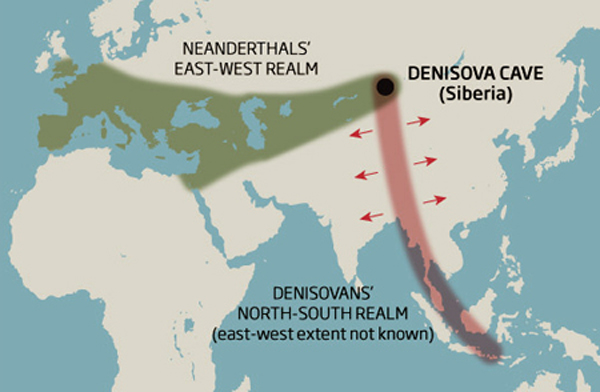


The vast Asian realm of the lost humans
Extract from Michael Marshall's article, NEW SCIENTIST, 29 September 2011

A tale of two Pleistocene realms: Neanderthals spread east and west through Eurasia - did Denisovans spread north to south?
The Denisovans, mysterious cousins of the Neanderthals, occupied a vast realm stretching from the chill expanse of Siberia to the steamy tropical forests of Indonesia - suggesting the third human of the Pleistocene displayed a level of adaptability previously thought to be unique to modern humans.
Our first tantalising glimpse of the Denisovans came last year with DNA analysis of a bone and tooth found in a Siberian cave. The DNA was distinct enough from Neanderthals' to suggest tens of thousands of years of independent evolution.
Before they disappeared, the Denisovans found time to interbreed with Homo sapiens. As a result, 5 per cent of the Denisovan genome lives on - not in the inhabitants of Siberia but in Papua New Guineans, living thousands of kilometres to the south-east.
Mark Stoneking, of the Max Planck Institute for Evolutionary Anthropology in Leipzig, Germany, has now compared the Denisovan genome with an additional 33 populations from mainland Asia, Indonesia, the Philippines, Polynesia, Australia and Papua New Guinea. He found Denisovan genes in east Indonesia, Australia, Papua New Guinea, Fiji and Polynesia.
That suggests that the Denisovan genes in Papua New Guinea were by no means a freak result. Instead, Stoneking thinks the Denisovans lived in south-east Asia, and that the interbreeding with modern humans happened there. If confirmed, the Denisovans' range is particularly startling because it runs north to south (see map above). Genetic evidence suggests that it is harder to migrate north-south than east-west, because climate and ecology change over shorter distances.
Across Asia in two waves
The genes of Denisovans in modern humans are helping to reveal how our species colonised Asia, Australia and the Pacific islands. Mark Stoneking of the Max Planck Institute for Evolutionary Anthropology in Leipzig, Germany, found Denisovan DNA in modern humans living in east Indonesia, Polynesia, Australia and Papua New Guinea. People from mainland Asia and west Indonesia didn't have any though, suggesting they are descendants of a second wave of modern humans across Asia - this time without Denisovan interbreeding. He suspects modern humans settled in the Middle East and migrated eastwards twice.
Independent support comes from Eske Willerslev of the Natural History Museum of Denmark in Copenhagen. His team sequenced the genome of an Indigenous Australian and compared it with Han Chinese, European and African genomes. They calculated that the Indigenous Australians split from the others between 75,000 and 62,000 years ago. The Chinese and European populations split between 38,000 and 25,000 years ago. That, again, suggests two migrations across Asia.
To view the full article http://www.newscientist.com/article/mg21128323.200-the-vast-asian-realm-of-the-lost-humans.html
by Bradshaw Foundation
Tuesday 21 March 2023
by Bradshaw Foundation
Tuesday 07 February 2023
by Bradshaw Foundation
Thursday 19 May 2022
by Bradshaw Foundation
Tuesday 19 October 2021
by Bradshaw Foundation
Friday 25 June 2021
by Bradshaw Foundation
Monday 09 November 2020
by Bradshaw Foundation
Tuesday 03 November 2020
by Bradshaw Foundation
Wednesday 28 October 2020
by Bradshaw Foundation
Tuesday 23 June 2020
by Bradshaw Foundation
Thursday 04 June 2020
by Bradshaw Foundation
Thursday 14 May 2020
by Bradshaw Foundation
Tuesday 12 May 2020
by Bradshaw Foundation
Wednesday 19 February 2020
by Bradshaw Foundation
Tuesday 21 January 2020
by Bradshaw Foundation
Monday 20 January 2020
by Bradshaw Foundation
Thursday 28 November 2019
by Bradshaw Foundation
Tuesday 21 March 2023
by Bradshaw Foundation
Tuesday 07 February 2023
by Bradshaw Foundation
Thursday 19 May 2022
by Bradshaw Foundation
Tuesday 19 October 2021
by Bradshaw Foundation
Friday 25 June 2021
by Bradshaw Foundation
Monday 09 November 2020
by Bradshaw Foundation
Tuesday 03 November 2020
by Bradshaw Foundation
Wednesday 28 October 2020
by Bradshaw Foundation
Tuesday 23 June 2020
by Bradshaw Foundation
Thursday 04 June 2020
by Bradshaw Foundation
Thursday 14 May 2020
by Bradshaw Foundation
Tuesday 12 May 2020
by Bradshaw Foundation
Wednesday 19 February 2020
by Bradshaw Foundation
Tuesday 21 January 2020
by Bradshaw Foundation
Monday 20 January 2020
by Bradshaw Foundation
Thursday 28 November 2019
Friend of the Foundation











